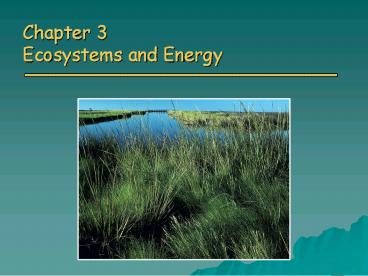Chapter 3 Ecosystems and Energy - PowerPoint PPT Presentation
1 / 23
Title:
Chapter 3 Ecosystems and Energy
Description:
Chapter 3 Ecosystems and Energy Question of the day: Draw a pyramid of energy. Fill in the appropriate trophic levels with these terms: goldenrod, tertiary consumer ... – PowerPoint PPT presentation
Number of Views:165
Avg rating:3.0/5.0
Title: Chapter 3 Ecosystems and Energy
1
Chapter 3Ecosystems and Energy
2
Question of the day
- Draw a pyramid of energy. Fill in the appropriate
trophic levels with these terms - goldenrod, tertiary consumer, secondary consumer,
mouse, Red tailed hawk, rattlesnake, producer,
primary consumer - Describe how energy is transferred between
trophic levels and the quantity of energy.
3
Overview of Chapter 3
- Ecology
- Energy
- First Law of Thermodynamics
- Second Law of Thermodynamics
- Photosynthesis and Cellular Respiration
- Flow of Energy Through Ecosystems
- Producers, Consumers Decomposers
- Ecological Pyramid
- Ecosystem Productivity
4
Ecology
- Ecology
- eco house logy study of
- The study of interactions among and between
organisms in their abiotic environment - Broadest field in biology
- Biotic- living environment
- Includes all organisms
- Abiotic- non living or physical environment
- Includes living space, sunlight, soil,
precipitation, etc.
5
Ecology
- Biology is very organized
- Ecologists are interested in the levels of life
above that of organism
6
Ecology Definitions
- Species
- A group of similar organisms whose members freely
interbreed - Population
- A group of organisms of the same species that
occupy that live in the same area at the same
time - Community
- Al the populations of different species that live
and interact in the same area at the same time - Ecosystem
- A community and its physical (abiotic)
environment - Landscape
- Several interacting ecosystems
7
Ecology
- Biosphere contains earths communities,
ecosystems and landscapes, and includes
- Atmosphere- gaseous envelope surrounding earth
- Hydrosphere- earths supply of water
- Lithosphere- soil and rock of the earths crust
8
Energy
- The ability or capacity to do work
- Chemical, radiant, thermal, mechanical, nuclear,
electrical - Energy exists as
- Stored energy (potential energy)
- Kinetic energy (energy of motion)
9
Thermodynamics
- Study of energy and its transformations
- System- the object being studied
- Closed System- Does not exchange energy with
surroundings (rare in nature) - Open System- exchanges energy with surroundings
10
Laws of Thermodynamics
- First Law of Thermodynamics
- Energy cannot be created or destroyed it can
change from one form to another - Ex organisms cannot create energy they need to
survive- they must capture it from another source - Focus is on quantity
- Second Law of Thermodynamics
- When energy is converted form one form to
another, some of it is degraded to heat - Heat is highly entropic (disorganized)
- Focus is on quality
11
Photosynthesis
- Biological process by which energy from the sun
(radiant energy) is transformed into chemical
energy of sugar molecules - Energy captured by plants via photosynthesis is
transferred to the organisms that eat the plants
6 CO2 12 H2O radiant energy
12
Cellular Respiration
- The process where the chemical energy captured in
photosynthesis is released within cells of plants
and animals - This energy is then used for biological work
- Creating new cells, reproduction, movement, etc.
C6H12O6 6 O2 6 H2O
6 CO2 12 H2O energy
13
Energy Flow
- Passage of energy in a one-way direction through
an ecosystem - Producers
- Primary consumers
- Secondary consumers
- Decomposers
14
Food Chains- The Path of Energy Flow
- Energy from food passes from one organisms to
another - Each link is called a trophic level
15
Food webs represent interlocking food chains that
connect all organisms in an ecosystem
16
Ecological Pyramids
- Graphically represent the relative energy value
of each trophic level - Important feature is that large amount of energy
are lost between trophic levels to heat - Three main types
- Pyramid of numbers
- Pyramid of biomass
- Pyramid of energy
17
Pyramid of Numbers
- Illustrates the number of organisms at each
trophic level - Usually, organisms at the base of the pyramid are
more numerous
- Fewer organisms occupy each successive level
- Do not indicate the biomass of the organisms at
each level or the amount of energy transferred
between levels
18
Pyramid of Biomass
- Illustrates the total biomass at each successive
trophic level - Biomass measure of the total amt of living
material
- Biomass indicates the amount of fixed energy at a
given time - Illustrates a progressive reduction in biomass
through trophic levels
19
Pyramid of Energy
- Illustrates how much energy is present at each
trophic level and how much is transferred to the
next level - Most energy dissipates between trophic levels
- Explains why there are so few trophic levels
- Energy levels get too low to support life
20
Ecosystem Productivity
- Gross Primary Productivity (GPP)
- Total amount of energy that plants capture and
assimilate in a given period of time - Net Primary Productivity (NPP)
- Plant growth per unit area per time
- Represents the rate at which organic material is
actually incorporated into the plant tissue for
growth - GPP cellular respiration NPP
- Only NPP is available as food to organisms
21
Variation in NPP by Ecosystem
22
Human Impact on NPP
- Humans consume more of earths resources that any
other animal - Humans represent 0.5 of land-based biomass
- Humans use 32 of land-based NPP!
- This may contribute to loss of species
(extinction) - Humans high consumption represents a threat to
planets ability to support both human and
non-human inhabitants
23
(No Transcript)































